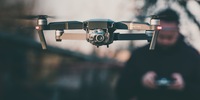
Photographing the stars in a different way
These days, everyone knows that you can take really good photos from the air using drones. Photographer Thomas Kunz and I reversed the situation and tried to photograph a drone in flight with a camera on the ground.
It's cold, very cold.Thomas Kunz and I are walking towards Sitysee equipped with cameras, a drone, camping chairs and something to eat. We won't even touch the food. It's too cold for that, no time for a break.
Our objective: to photograph the drone in the air as it follows a programmed path with Thomas's camera. A long exposure allows us to photograph the night sky. As the drone alone isn't bright enough, I bought a landing gear with a built-in torch. This ensures that the camera will also capture the light from the drone and that we will see the path traced by the drone in the photo.

We're also downloading the Litchi app for 23 francs. The app allows you to plot routes in the PC browser and then transfer them to the smartphone. It couldn't be simpler. The DJI Go app can also be used to automate flights with waypoints. This time, it's all done on smartphone, so it's less intuitive to use.

Once the route has been plotted, downloaded to the smartphone and the phone connected to the drone's remote control, we start the mission at the press of a button. Fortunately, I'm able to keep my already nearly frozen hands a little warmer by slipping them into my jeans pockets during the mission. Meanwhile, Thomas has to hold down the camera shutter button for between 40 and 90 seconds. Flight times vary quite widely depending on the subjects.
Furthermore, the cold doesn't make it easy on the batteries. All but the Nikon D810 quickly gave up. With over 70% of the battery still remaining, we had to change the batteries on the Sony A7S II, which we needed for filming, four times. After about eight flights and an accident with a pole on the other side of the lake, we finished. We've taken some great pictures of the sky, the drone's batteries are empty and our fingers are about to fall off. Now that's what I call a successful mission!
It took us two hours, admittedly we're both hypothermic, but all the shots in the box. Suddenly a silhouette emerges from the darkness. The neighbouring farmer took an interest in our project and was delighted that we had ended up here. Fifteen minutes later, we're back in the warmth of the car and heading back to the village. Just as hungry and thirsty as two hours earlier.
In the video above (in German), we explain exactly how we did it and the difficulties we encountered.




As a Multimedia Producer, preparing multimedia content and knowing about cutting-edge technology is my business. My main focus at digitec is producing videos. I can’t wait to try out new products such as cameras, drones or smartphones as soon as they’re launched. This is where being at the source comes in rather handy. When I’m not working, I’m probably skiing, biking or hiking – the mountains are my place to be.


